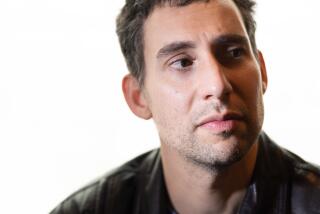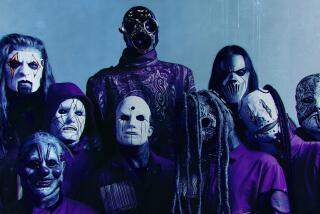Live in the Slow Lane : Don’t tell the idealistic Pennsylvania rockers that they have to be jaded to be comfortable in the Top 10. Like their single ‘Lightning Crashes,’ their career started out quietly and is building to a major crescendo.
- Share via
MANSFIELD, Pa. — Patrick Dahlheimer and Chad Gracey, bassist and drummer for the rock band Live, are sitting in the lobby of a small motel here, grappling with one of the great moral dilemmas of rock stardom.
It’s arrived in the form of a young woman with short red hair and a coy, flirtatious demeanor, and, gosh, she has traveled eight hours from West Virginia to see these guys play and she’s kinda hoping that they’re planning on spending the night here, ‘cause she’d love to party with them after the show. Oh, and so would her girlfriends.
For the record:
12:00 a.m. May 7, 1995 FOR THE RECORD
Los Angeles Times Sunday May 7, 1995 Home Edition Calendar Page 91 Calendar Desk 1 inches; 22 words Type of Material: Correction
Live label--The band Live records for Radioactive Records, which is distributed by MCA Records. An article last Sunday misstated the group’s affiliation.
Gracey smiles at her politely.
“Sorry,” he says, “but we’re leaving after the show.”
“Yep,” Dahlheimer says. “Going home.”
“Gee, that’s too bad,” the redhead sighs. “So, um, why are you playing out here, anyway?”
The musicians had just been asking themselves the same question.
With singer Ed Kowalczyk and guitarist Chad Taylor, they’ve been on the road for close to a year promoting “Throwing Copper,” which has sold more than 2 million copies--and just reached No. 1 on the nationwide album chart.
They’ve headlined at high-profile clubs and performed at festivals in stadiums packing tens of thousands of fans. (The band plays the Santa Barbara County Bowl on May 19.)
And yet here they are in tiny Mansfield, finishing up a leg of a tour that’s brought them to about 20 other small college towns--places where even the groupies have to be shipped in.
“This is the ‘S--- Towne’ tour, man,” Kowalczyk says later with a laugh, while grabbing lunch at a family-style restaurant--the only kind in these parts, apparently--near the motel. He’s alluding to one of the songs on “Copper,” Live’s second full-length album.
On the surface, the song is about small-town small-mindedness. But there’s a current of hope running through it, a certain faith in the human spirit’s ability to transcend such stuff.
This sort of conviction is key to all of Live’s music. While the band has been sharing the upper reaches of the rock and pop charts with groups that specialize in nihilism or kitsch--or some combination thereof, a la Green Day--Live invests its driving, muscular rock songs with an intense earnestness and a shameless idealism.
Its current Top 10 single, a poignant bolero called “Lightning Crashes,” both celebrates life and ennobles death by connecting the passing of an old woman and the birth of a child with the same angel overseeing both milestones.
The other tracks on “Copper,” on MCA Records, are also rife with spiritual and Christian imagery, none of it pedantic or partisan.
It comes as little surprise, then, that Live sought from the start to pattern its career after a supergroup known--especially in its earlier days--for parlaying religious influences into mass secular appeal.
“We all learned a lot from a book about U2,” Kowalczyk says, referring to “Unforgettable Fire” by Irish journalist Eamon Dunphy.
“We related (to U2) so much,” adds Taylor, who has joined Kowalczyk at the restaurant. “Reading the biography was in many ways like reading a story about ourselves, except with different names.”
*
The seeds of Live’s success were planted about a decade ago in York, Pa., a town much smaller than U2’s Dublin, Ireland, and not much bigger than Mansfield.
The band members, who were in their early teens, all lived within a mile of each other and would jam together after school.
“Ed and I would sit in the back of our classrooms,” Taylor says, “and instead of working on, like, calculus, we’d think about the kind of tour bus we’d have.”
If U2 provided the fledgling group with a blueprint for its career, the band that had perhaps the greatest effect on its musical approach was R.E.M. For one thing, Kowalczyk’s baritone voice was more comfortable in Michael Stipe’s range than in that of U2’s Bono. And since all four teen-agers were rabid R.E.M. fans, it seemed natural to cut their artistic teeth on that band’s material.
When Live began doing originals, Kowalczyk would write the lyrics and the basic melodies and the others would craft their own parts for the finished product. Though this process has endured--producing the songs that appeared on Live’s 1991 debut EP, “Death of a Dictionary,” and its first album, 1992’s “Mental Jewelry,” as well as “Throwing Copper”--the band remains resolutely a band, as opposed to a singer-songwriter supported by three other guys.
But Taylor is diplomatic about the fact that, as Live’s frontman, Kowalczyk is destined to get the most attention.
“I think Ed’s got the kind of face you remember,” the guitarist says. In the soberly dramatic video for “Lightning Crashes,” which has been one of MTV’s most requested in recent months, the entire band is featured prominently, but Kowalczyk inevitably becomes the focus--in part because of his fervent delivery of the song, in part because of his natural lead-singer charisma.
Clearly, for Kowalczyk and his bandmates, the prospect of super-high visibility is something to be regarded with ambivalence.
It’s not that these young men, like so many other artists in their 20s, claim to disdain mainstream success; to the contrary, they’re refreshingly honest about their delight in playing bigger venues and their desire to expand their fan base even more in the future. But they do fear what Kowalczyk refers to as “Live saturation.”
“We don’t want Offspring-itis, Green Day-itis,” the singer says. “You know, that thing where bands are all over the place at once, getting everything at once--major airplay on radio, major airplay on MTV.”
In fact, MTV’s immediate and enthusiastic endorsement of Live inspired some resentment at first, particularly from the sort of alternative-rock purists who buy into that anti-commercial-success mentality. Kowalczyk, for his part, is not unsympathetic to their wariness.
“It’s a lot for people to swallow that we’re all about 23 years old”--at 24, Taylor is the oldest--”and we have an album out that’s sold 2 million copies and we’ve gotten played on MTV all the time, from the beginning. It would probably be a lot for me to swallow if I wasn’t in the band, if I didn’t know our history. I’d probably think, ‘Who’s their dad? Does he own Viacom or something?’ ”
Where the critics are concerned, Live has gotten much better notices for “Throwing Copper” than it did for “Mental Jewelry,” an album on which Kowalczyk--then barely out of his teens--alluded heavily to the writings of Indian spiritual philosopher J. Krishnamurti and put forth social commentary in a manner that some considered heavy-handed or naive.
Still, Live hasn’t been embraced by the press as heartily as a lot of trendier, more flagrantly punk-influenced bands have. For the band’s manager, Peter Freedman, that’s not necessarily a drawback.
“We make decisions based on the long term,” New York-based Freedman says. “I’m not interested in Live being the biggest thing in 1995. I’m interested in Live being around for 20 years.”
Kowalczyk isn’t in any rush to be a household name either.
“At this point, we at least still have some anonymity,” the singer says. “Like, I still hear stories about people who call up deejays and say, ‘The video’s got a baby being born in it, and the song goes a little something like this. Who the hell is that?’ I think that may be because of our name. People think, ‘Live?’ It doesn’t register that we’re a band. It allows some mystique about who we really are, what’s really going on. And that’s kind of cool.”
Guitarist Taylor agrees: “I’d like for that mystique to always be around us. We didn’t have to create it, but I feel like it’s something that could slip away or be taken away. All these bands today that are so overexposed--they didn’t necessarily create that mess themselves. It’s just that you hear their names so much, you see their images so much, that it begins to not feel like rock ‘n’ roll anymore. It feels like . . . cereal or something.”
Like their heroes in U2 and R.E.M.--who, by the way, have expressed mutual admiration (Bruce Springsteen and Eddie Van Halen are also fans)--the members of Live try to stave off such risks by putting on concerts that abound in raw, real energy and by confronting fame with their feet on the ground.
Drummer Gracey sounds entirely earnest when he says, “The only pressure I feel right now is to make a better record.” Taylor says Live will probably head back into the studio in December or January.
“I think that there are a lot of people who bought (“Throwing Copper”) when it first came out who are killin’ for a new album,” he says. “And we wrote those songs a year before that, so we’re 10 times as eager.”
By the time they do record, the band will have completed yet another leg of training, one that will take Live to arenas in major cities.
For now, though, Mansfield awaits. Having finished lunch, Kowalczyk returns to the motel, where Gracey and Dahlheimer inform him about the coquette from West Virginia. The singer laughs quietly, but then his interviewer suggests that a really happening radio and MTV star should want to reap the fruits of his celebrity.
“OK, man,” he says, standing tall. “Where is she? I’m gonna find her--and give her a big hug.”*
* Live plays May 19, 8 p.m., at the Santa Barbara County Bowl, 1122 N. Milpas St., Santa Barbara. $16. (805) 568-2695.
More to Read
The biggest entertainment stories
Get our big stories about Hollywood, film, television, music, arts, culture and more right in your inbox as soon as they publish.
You may occasionally receive promotional content from the Los Angeles Times.










